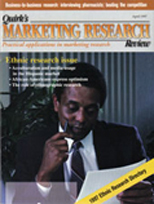Editor's note: Felipe Korzenny, Ph.D., is president; Rebecca Abravanel, Ph.D., is director of quantitative research; and Adrien Lopez Lanusse is research analyst, at Hispanic & Asian Marketing Communication Research, Inc., Belmont, Calif.
Spanish-dominant Hispanics are influenced by Spanish language television ads to a larger extent than by English language ads. This may sound like a simple truism but it is not.
Consider this: The largest Hispanic markets in the U.S. are Los Angeles, New York, Miami, the San Francisco-San Jose area, Chicago and Houston. In each of those markets, Hispanics have many more television choices in English than in Spanish.
Spanish language choices are generally two, i.e., Univision and Telemundo, and in some cases up to five options, if cable or satellite are included. In contrast, English language channels can number 50 or more depending on cable or satellite availability.
A reasonable marketer may then conclude that English language television has a better chance of reaching even Spanish-dominant consumers. After all, television ads are highly visual and one might therefore conclude that most people should be able to understand them.
Qualitative U.S. Hispanic research has suggested that Spanish language ads are more effective than English language ads in persuading Spanish-dominant consumers for several reasons:
- Language alone helps increase understanding of the ad if the person is not fluent in English. Consider that only about 40 percent of U.S. Hispanics report being totally fluent in English and that 75 percent of Hispanics report speaking Spanish at home (these are 1990 census figures). Language alone, then, can make a difference in terms of denotation alone, i.e., being able to understand what the ad says.
- Further, there are contextual aspects in culturally tailored ads that communicate beyond words. A typical example is the use of humor because it doesn't always translate well across cultures. Another is the emotional or cultural relevance of the ad's context for the consumer. Hispanics tend to enjoy food and many other consumer products in the company of friends and family. Other contextual aspects include music, backgrounds, models or talent, communication styles, themes, etc.
- Additionally, Hispanic consumers have generally said they ascribe goodwill to advertisers who communicate to them in Spanish. Hispanics often view Spanish language advertising as sign of recognition and respect on the part of the advertiser.
Also, dubbed or translated ads do not seem to do as well as those produced originally in Spanish with Spanish-speaking talent. The contextual cues of translated ads tend to be missing and the emotional appeal tends to be lower.
Is there, then, any evidence that Spanish language television ads are more effective among U.S. Spanish-dominant Hispanics? A study conducted in November and December of 1996 in the greater San Francisco-San Jose area provided such evidence. It was a telephone survey conducted with women heads of household who indicated speaking Spanish at home most of the time and being most comfortable communicating in Spanish. Interviews were conducted in Spanish with 314 randomly selected respondents who have listed telephone numbers.
First, it is important to notice that exposure to Spanish language television was about twice as prevalent as that to English television. The average weekly exposure to Spanish television was 15.8 hours in contrast to 7.5 for English television. This is despite the fact that these consumers have much more opportunity to watch English television. Thus, watching Spanish language television seems to have added value gratification.
Second, and probably of greater importance, is the finding that Spanish language television advertising was quoted as being twice as impactful in producing sales than English television advertising. Respondents were asked, "Think about the products you have purchased in the past month. Did any advertisement you saw on Spanish language television influence any of these purchases?" Almost half the sample (46 percent) said they had been so influenced. The response to a parallel question regarding English language advertising was that less than a quarter of the sample (23 percent) had been influenced. The substantive difference in impact between advertising in the two languages suggests that language, as part of culture, can strongly affect decision making.
Additional evidence in favor of Spanish language advertising was that a relatively large segment of the sample indicated they would place more credence in a Spanish language ad than in the same ad in English. Thirty-nine percent of the respondents indicated they would believe most the version of the ad in Spanish than in English. Only 3 percent said they would put more credence in the English language version.
The implications for marketing practice seem obvious. If the marketer is eager to reach Spanish speaking consumers s/he may do best in trying to communicate to them in their primary language.
The implications for research practice are also important. Conducting Spanish language research, both qualitative and quantitative can render insights that may only be discernible if a concerted effort is done to reach those who prefer speaking Spanish. Insights derived from Spanish language research are more likely to reflect the attitudes and behaviors of the growing Spanish-dominant base of Hispanic consumers in the US (it is calculated that there are approximately 30 million Hispanic consumers in the U.S. About half of the size of the market has been estimated to have been generated by immigration during the past 15 years).
